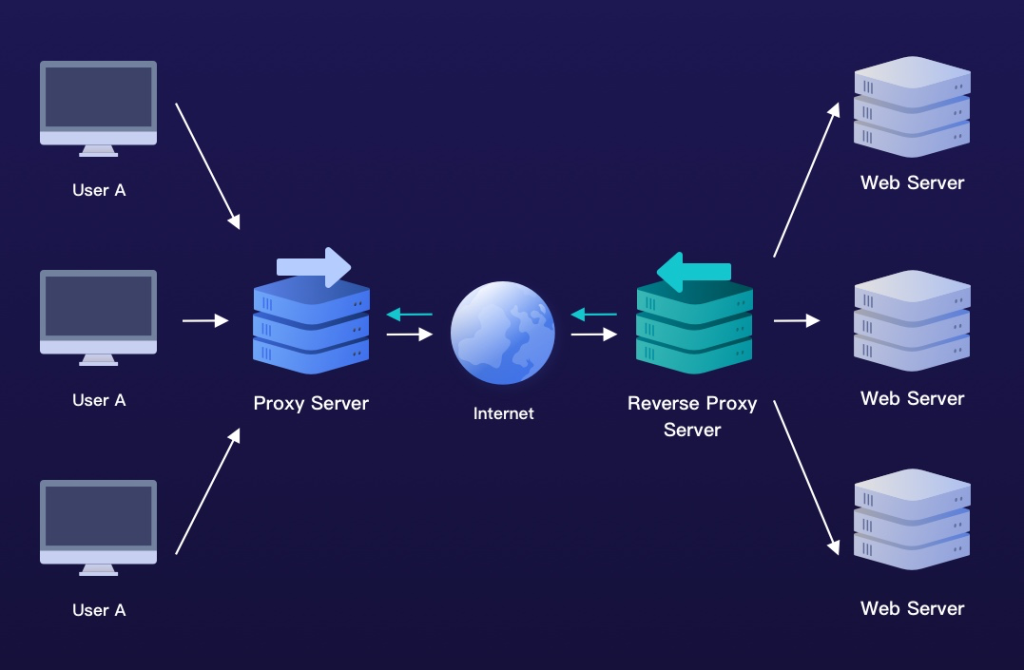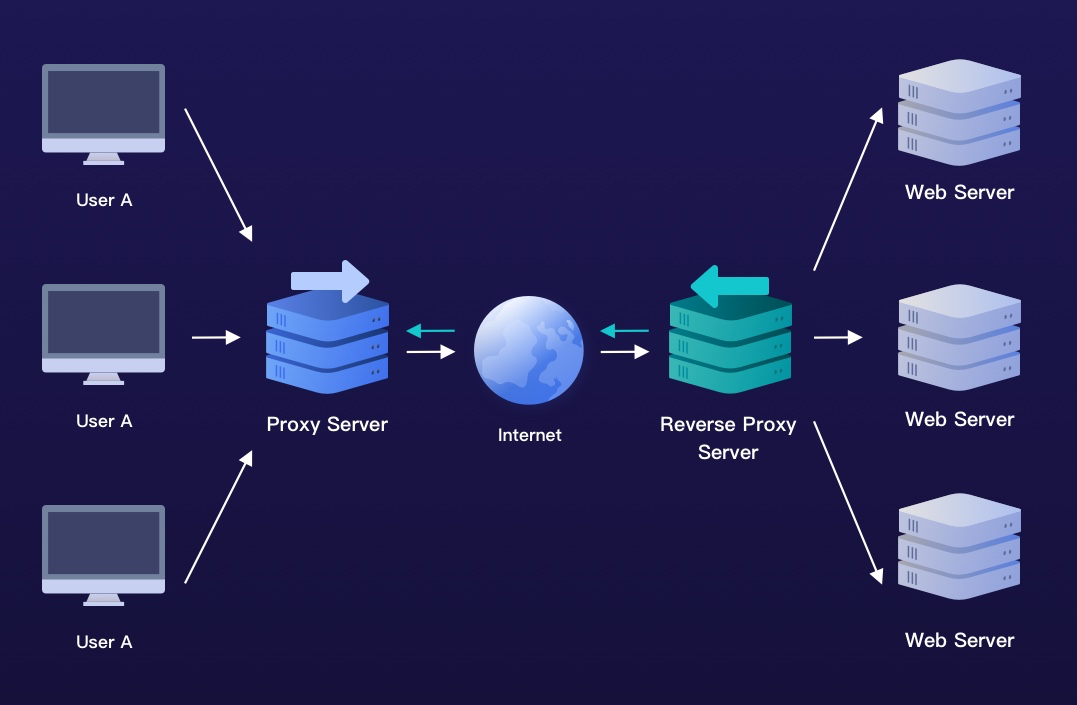Introduction
Proxies play a vital role in online security, traffic management, and data access. Whether businesses want to enhance user privacy, bypass restrictions, or optimize network performance, proxies offer valuable solutions. However, there is often confusion between reverse proxies and proxy servers (also called forward proxies).
While both serve as intermediaries between users and the internet, their roles and functions differ significantly. Reverse proxies help manage inbound traffic to servers, while traditional proxy servers assist users in accessing external content securely.
In this article, we will explore the core differences between reverse proxies and proxy servers, their applications, and how Cherry Proxy provides robust solutions for both types of proxy needs.
What Is a Proxy Server?
A proxy server (or forward proxy) acts as an intermediary between a client (user) and the internet. When a user sends a request to access a website, the proxy server forwards the request on behalf of the user, masking the user’s IP address and adding a layer of security.
One of the primary functions of a proxy server is enhancing anonymity by hiding users’ real IP addresses, making it difficult for websites to track their online activity. Businesses and individuals also use proxy servers to bypass geo-restrictions, allowing access to content blocked in certain regions. Additionally, organizations can use proxy servers for content filtering, restricting access to specific websites for security or productivity purposes. Another significant function is caching data, which stores frequently accessed content to improve loading speeds and reduce bandwidth usage.
Proxy servers are widely used in different scenarios. Businesses implement them to prevent employees from accessing non-work-related websites, while consumers use them to access streaming services from different countries. Security professionals also rely on proxy servers to mask online activity and prevent tracking.
What Is a Reverse Proxy?
A reverse proxy is a type of proxy that sits between clients and web servers, handling incoming requests and directing them to the appropriate backend server. Unlike forward proxies, which protect users, reverse proxies protect servers from threats and help manage network traffic efficiently.
Reverse proxies serve multiple purposes. They provide load balancing by distributing incoming traffic among multiple servers, preventing overload and improving performance. Another essential function is enhanced security, as reverse proxies hide the identity and IP addresses of backend servers, protecting them from cyber threats such as DDoS attacks.
Additionally, SSL termination is a key feature, where the reverse proxy handles the encryption and decryption of HTTPS requests, reducing the burden on web servers. Reverse proxies also contribute to caching and compression, storing frequently accessed content and reducing data size to optimize performance.
Common use cases of reverse proxies include large websites that distribute traffic across multiple servers for better reliability. Security protection is another major application, as businesses use reverse proxies to shield their servers from malicious attacks. E-commerce platforms also benefit from reverse proxies, as they ensure fast and secure online transactions by managing traffic effectively.
Reverse Proxy vs Proxy Server: Key Differences
While both reverse proxies and proxy servers function as intermediaries in network communication, they have distinct purposes. A proxy server (forward proxy) primarily protects users by enabling anonymous browsing and helping them access blocked content. It operates between users and the internet, ensuring that online requests pass through the proxy before reaching the target website. In contrast, a reverse proxy protects servers by managing incoming traffic and ensuring security. It sits between clients and web servers, handling requests before they reach backend servers.
Another key difference lies in IP masking. A forward proxy hides users’ IP addresses, ensuring privacy and anonymity online. A reverse proxy, on the other hand, hides the IP addresses of backend servers, preventing attackers from directly targeting them.
In terms of security benefits, proxy servers protect individual users by preventing websites from tracking their online activity. Reverse proxies focus on protecting servers from cyber threats such as DDoS attacks, unauthorized access, and traffic spikes.
Both proxies also optimize performance, but in different ways. A proxy server improves browsing speed for users through caching and bandwidth control, reducing the need to repeatedly download the same content. Reverse proxies enhance server performance through load balancing and traffic distribution, ensuring that no single server is overwhelmed with requests.
How Cherry Proxy Enhances Proxy Solutions
Whether you need a forward proxy for anonymous browsing or a reverse proxy for server protection, Cherry Proxy offers high-performance solutions tailored to different business needs.
1. Secure and Anonymous Browsing
Cherry Proxy provides residential proxies that use real IP addresses to prevent detection and ensure anonymous browsing. Users can access geo-restricted content and bypass censorship without revealing their identity.
2. Bypassing IP Blocks and Captchas
Websites often implement IP bans and captchas to prevent automated data access. With Cherry Proxy’s rotating IPs and advanced proxy pools, businesses can collect data without getting blocked.
3. Load Balancing and Traffic Distribution
For businesses managing high-traffic websites, Cherry Proxy’s reverse proxy services improve performance by evenly distributing network traffic and ensuring uninterrupted service.
4. Protection Against Cyber Threats
With built-in DDoS mitigation and SSL encryption, Cherry Proxy prevents malicious attacks and ensures secure communication between servers and clients.
5. High-Speed and Reliable Connections
Unlike free proxy services that compromise speed and security, Cherry Proxy provides high-bandwidth connections with low latency, ensuring smooth data transfers.
Use Cases of Cherry Proxy for Businesses
E-commerce:
Ensures fast page loading times and secure transactions.
Cybersecurity Firms:
Uses proxy services to analyze threats and protect user data.
Market Research Companies:
Collects competitor insights without being detected.
Streaming Services:
Bypasses regional content restrictions for global access.
Conclusion
Both proxy servers and reverse proxies play essential roles in network security, performance optimization, and data access. While proxy servers protect users by enabling anonymous browsing and bypassing restrictions, reverse proxies protect servers by managing traffic and enhancing security.
With Cherry Proxy, businesses can leverage the best of both technologies, ensuring secure, efficient, and unrestricted internet access. Whether you need an advanced forward proxy for data collection or a reverse proxy for traffic management, Cherry Proxy provides the ultimate solution for seamless online operations.
FAQ
What is the difference between proxy and reverse proxy server?
A proxy server (forward proxy) sits between users and the internet, helping with anonymity, access control, and bypassing restrictions. A reverse proxy sits between users and backend servers, providing security, load balancing, and performance optimization.
Proxy Server: Protects users, forwards requests to external sites.
Reverse Proxy: Protects servers, manages traffic to internal resources.
For example, a forward proxy helps users access blocked content, while a reverse proxy secures and optimizes web services.
What is the difference between proxy and proxy server?
A proxy is a general term for any system that acts as an intermediary between a user and another network or service. A proxy server is a specific type of proxy that runs on a dedicated machine or software, handling requests and forwarding data between clients and web resources.
In short:
Proxy: A broad concept that includes any intermediary mechanism.
Proxy Server: A dedicated server that performs proxy functions, such as filtering, caching, and security.


